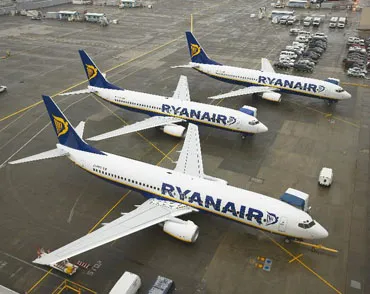
Ryanair to slash jobs amid warning it has 900 excess crew
Aug 02, 2019

Ryanair is facing significant operational challenges and has announced plans to reduce its workforce as it grapples with an excess of around 900 crew members. The airline's management has indicated that this surplus is unsustainable, prompting the need for job cuts to streamline operations and manage costs effectively. The decision comes amidst broader industry pressures and shifts in demand, leading to a reassessment of staffing levels. Ryanair aims to restructure its workforce to align with current market conditions while maintaining its commitment to providing low-cost flights across Europe.
Ryanair, the well-known low-cost airline, is making headlines for its recent announcement regarding significant job cuts. The airline has revealed that it currently has 900 excess crew members, prompting concerns in the aviation industry. This decision has raised questions about the future of air travel and its impact on employees. In this article, we will explore the implications of Ryanair's job cuts, the reasons behind them, and what this means for the airline and its crew members.
The Background of Ryanair's Job Cuts
In recent months, Ryanair has faced various challenges, including fluctuating passenger demand and rising operational costs. The airline's management has indicated that the overstaffing issue has become unsustainable, leading to the decision to reduce its workforce. The excess crew situation stems from several factors, including:
- Seasonal fluctuations in travel demand
- Increased competition in the airline industry
- Rising fuel prices impacting operational budgets
These factors have contributed to a situation where Ryanair has more crew members than needed for its current flight schedules, leading to the difficult decision to reduce staff.
Impact on Employees and Crew Members
The announcement of job cuts has understandably caused concern among Ryanair's crew members. With 900 positions potentially at risk, many employees are left wondering about their job security and future prospects within the airline. Here are some key points to consider:
- Job security: Crew members are anxious about their employment status, as job cuts often lead to uncertainty and financial strain.
- Potential for voluntary redundancy: Ryanair may offer voluntary redundancy packages to reduce the workforce, allowing some employees to leave on their terms.
- Impact on morale: The news of job cuts can lead to decreased morale among remaining staff, affecting productivity and service quality.
Ryanair's management has assured employees that they will be kept informed throughout the process and that support will be provided to those affected by the job cuts.
Reasons Behind the Decision
Understanding the rationale behind Ryanair's decision to cut jobs requires examining the broader context of the airline industry. Several factors have contributed to this decision:
| Factor | Impact on Ryanair |
|---|---|
| Post-Pandemic Recovery | While air travel has rebounded, demand remains inconsistent, leading to overstaffing. |
| Operational Costs | Rising fuel prices and maintenance costs have squeezed profit margins. |
| Market Competition | Increased competition from other low-cost carriers has pressured ticket prices and profitability. |
As the industry continues to recover from the pandemic, airlines like Ryanair must adapt to changing market conditions, which may involve tough decisions, including workforce reductions.
Future Outlook for Ryanair
Despite the current challenges, Ryanair remains optimistic about its future. The airline is known for its resilience and ability to adapt to changing circumstances. Here are some potential strategies Ryanair may pursue to navigate through this difficult period:
- Streamlining operations: By optimizing flight schedules and crew assignments, Ryanair can improve efficiency and reduce costs.
- Focus on profitability: The airline may prioritize profitable routes and reduce spending in areas that do not contribute to its bottom line.
- Investment in technology: Ryanair may invest in technology that enhances operational efficiency and improves the customer experience.
Furthermore, Ryanair has plans to expand its route network, which could create new job opportunities in the long run, even if short-term cuts are necessary.
Conclusion
Ryanair's decision to cut jobs amid a backdrop of excess crew members highlights the ongoing challenges faced by the airline industry. While the news is undoubtedly concerning for those affected, it also reflects the necessity for airlines to remain agile in a competitive landscape. With strategic adjustments and a focus on operational efficiency, Ryanair aims to weather the storm and emerge stronger in the future. Crew members and passengers alike will be watching closely to see how these developments unfold.
As Ryanair navigates this turbulent period, it will be essential for the airline to communicate transparently with its employees and customers. The focus on efficiency and profitability will play a crucial role in determining Ryanair's success as it adjusts to changing market conditions.
Related Articles

Explore Thailand: The Best Islands to Visit for Paradise, Adventure, and Relaxation

The Ultimate Guide to the Best Islands in Thailand for Your Next Getaway

Do babies need passports? How to get a passport for a newborn

How to get a U.S. passport fast: here’s how to expedite the process

What is Mobile Passport Control: 5 reasons why you should use it

SENTRI vs. Global Entry: A detailed guide

Do you need a passport to go to the Bahamas? Let’s find out

Do you need a passport to go to Mexico? A detailed guide

Do you need a passport to go to Canada? We got the answer

Do You Need a Passport for a Cruise: An Essential Travel Guide

Booster Seat Requirements: All the Rules to Follow in Your Rental Car

What Are the World’s Most Powerful Passports, and How Does Yours Rank?

How to Take a Passport Photo at Home: A Helpful Guide

You've got to have heart! Southwest's new livery

Your opinion: Should water be free on low cost carriers?

Young women bolder than guys as solo travellers
